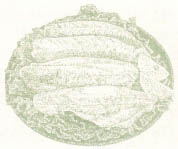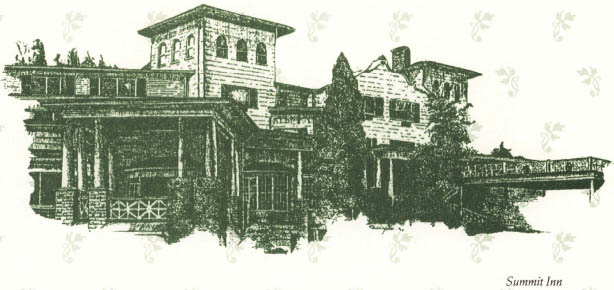

The average citizen enjoys hearing of the comings and goings of prominent individuals. From our founding fathers to modern entertainers, well-known guests have visited the restaurants in this chapter. We can’t promise that anyone other than John Q. Public will be dining during your visit, but you’re sure to enjoy the menu selections, just as the celebrities did.
138 SOUTH SECOND STREET
PHILADELPHIA, PA 19106
215-413-1443
When its door first opened in 1773, this place was described as “a large and commodious tavern.” It was commissioned and built by subscription. A group of fifty-three investors who wanted to create the atmosphere of a London tavern came together to raise the money. Situated near the city’s center, the City Tavern soon became a place for important people to meet. The first proprietor, Daniel Smith, is known to have leased the tavern for the princely sum of three hundred pounds a year.
In late 1774, it was used as an informal gathering place for the members of the First Continental Congress. Such well-known men as George Washington, Thomas Jefferson, and Richard Henry Lee could be found here discussing politics and taking their meals in the private dining rooms. Indeed, John Adams once called it “the most genteel tavern in America.”
Throughout the next eighty years, the City Tavern maintained its importance by serving the public in many ways. American and British forces both used the tavern for housing prisoners of war during 1776 and 1777. Many famous court-martials were held here during that time. In 1789, the tavern became the Merchants’ Coffee House and Place of Exchange, the first place that merchants visited upon their arrival in Philadelphia. Patrons could share newspapers, discuss the latest shipping news, and conduct business. By 1799, the City Tavern was the most important financial institution in the city.
Today, the City Tavern continues to reflect the ambiance of the eighteenth century. The wait staff dresses in historically correct, handmade period clothing, adding charm to the elegant colonial surroundings. Culinary historians have lent their expertise to determine the ingredients and beverages used in days gone by.
On the day we visited, we were met by Karina Kachurak, the director of public relations for Walter Staib, the current proprietor. She recalled tales about the painstaking research carried out to ensure that countless items in the tavern are in keeping with the time period. Everything—from the lead-free pewter serving ware on all the tables to the brass candlesticks to the specially made dishes—has been researched and verified.
Karina encouraged us to sample many of the delightful dishes on the lunch menu. We began with a glass of Shrub, a fruit-and-vinegar concentrate usually topped off with water (or something a little stronger). Then came a fine selection of breads—Sally Lunn, Anadama, and Sweet Potato Biscuits made with pecans and molasses, reputed to be Thomas Jefferson’s favorite! Both the Mallard Duck Sausage and the West Indies Pepper Pot Soup were delicious and full of flavor, though the Cold Cucumber Soup was our personal favorite. Karen enjoyed the Colonial Turkey Pot Pie, which contained tender chunks of turkey mushrooms, early peas, and red potatoes in a Sherried Cream Sauce, topped by light, flaky pastry. Debbie opted for the Roast Platter, which consisted of smoked chicken, roasted meats, and baked ham. She found her dish just as appetizing. We have to be honest and relate that we sampled every single dessert on the menu, and they were all fabulous. We encourage you to step back in time and visit the City Tavern, “a triumph of tradition.”

 WEST INDIES PEPPER POT SOUP
WEST INDIES PEPPER POT SOUP 
¾ pound salt-cured pork, chopped
¾ pound salt-cured beef, chopped
2 tablespoons vegetable oil
1 medium white onion, chopped
4 cloves garlic, chopped
¼ Scotch Bonnet pepper, seeded and chopped
1 cup scallions, chopped
1 pound taro root, peeled and cut into 2-by-¼-inch strips
16 cups chicken stock
2 bay leaves
1 teaspoon fresh thyme, chopped
1 tablespoon freshly ground allspice
1 tablespoon freshly ground black pepper
1 pound callaloo or collard greens, rinsed and chopped
salt and pepper to taste
In a large stockpot, sauté pork and beef in oil over high heat for 10 minutes until brown. Add onions, garlic, and Scotch Bonnet pepper and sauté for 3 to 5 minutes until onions are translucent. Add scallions and sauté for 3 minutes. Add taro root and sauté for 3 to 5 minutes until translucent. Add chicken stock, bay leaves, thyme, allspice, and black pepper. Bring to a boil over high heat, then reduce heat to medium and cook for about 30 minutes until meat and taro root are tender. Stir in callaloo. Reduce heat and simmer for about 5 minutes until wilted. Season with salt and pepper. Serves 10.
Note: To salt-cure pork and beef rub an entire well-marbled shoulder of meat with coarse salt and refrigerate for at least 3 days. Wash salt off meat before cooking.

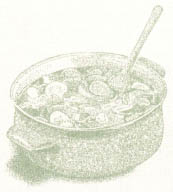
 RICE PUDDING
RICE PUDDING 
2 cups water
¾ cup long-grain white rice, uncooked
2½ cups whole milk
½ cup granulated sugar
3 large eggs
1½ tablespoons unsalted butter, softened
1½ teaspoons vanilla extract
2 teaspoons ground cinnamon, divided
Preheat oven to 325 degrees. In a 2-quart saucepan, bring water to a boil and add rice. Simmer covered for 15 to 20 minutes, then let stand covered for 5 minutes; drain if necessary. In a separate saucepan, bring milk to a boil. Stir in rice and cook for 10 minutes until grains become soft. In a large bowl, whisk together sugar, eggs, butter, vanilla, and 1 teaspoon of the cinnamon. Gradually stir rice mixture into egg mixture. Place in a 2-quart ovenproof glass or ceramic dish, then place dish in a larger, high-sided roasting pan. Carefully pour boiling water into roasting pan to a depth of 1½ inches around dish. Bake covered for 20 to 30 minutes until a knife inserted near the center comes out clean. Sprinkle remaining cinnamon on top as a garnish. Serves 6.

2519 DEKALB PIKE
NORRISTOWN, PA 19401
610-275-3407
The elegant structure that we now know as The Jefferson House Restaurant was built as a private residence in 1848. When the estate was partially destroyed by fire in 1920, an architect rebuilt the home in a style strongly influenced by a Thomas Jefferson design. Today, the property encompasses not only the mansion and its seven dining rooms but also ten acres of landscaped grounds, a wooded duck pond, a 150-year-old springhouse, a fountain, and two Italian gazebos.
Angelo Romano and his wife, Betty, have a thirty-year history here. The Romanos, their daughter, Linda Romano Groff, and their son-in-law, Thomas Groff, own and operate The Jefferson House. Angelo’s career includes significant events dating back to when he was seventeen years old. At that time, he was apprenticed to master chef Henry Sidoli at the Warwick Hotel in Philadelphia. One day, none other than baseball legend Joe DiMaggio walked in and ordered a hamburger. The chef told young Romano to instead prepare a seven-course meal. Duly impressed, DiMaggio asked to meet the creator of his feast. The athlete predicted that the young man would one day own his own restaurant. Romano responded by saying, “Mr. DiMaggio, if that comes true, I will owe you another dinner.” Thirty-five years later, DiMaggio booked a table at The Jefferson House Restaurant. Unbeknownst to him, his prediction had come true, and Romano now owned the restaurant. Once again, Angelo Romano created the most elaborate meal he could concoct. Afterward, he revealed his identity and reminded DiMaggio of the earlier occurrence. As Romano began the story, the ballplayer quickly chimed in and finished the tale of the dinner thirty-five years prior. DiMaggio didn’t pay for his meal after this second encounter. After all, Romano had made a promise that he intended to keep.
During our Sunday visit to The Jefferson House, Mr. Romano greeted guests and saw to their needs with a well-deserved pride. The mansion-turned-restaurant is exquisite in its decor. We were thrilled to be seated in the elegant dining room overlooking the patio and the springhouse, where we enjoyed a lovely view of the grounds. We opted for the prix fixe menu, which is very reasonably priced and available during certain hours every day. Although Karen started with a salad, she had to taste Debbie’s Crab Bisque, which we declared the best soup either of us had eaten in quite a while. It was creamy and absolutely full of crab. Nut-Encrusted Pork Loin topped with Berry Sauce and an entrée of Cajun Catfish followed. Both were served with a selection of Steamed Fresh Vegetables. Since we had skipped breakfast, we both had room for a lovely dessert. Karen chose a Profiterole, served with Ice Cream and Chocolate Sauce. The Tart that satisfied Debbie’s sweet tooth was full of mixed berries housed in a soft crust. It was a choice that was popular with the guests around us, many of whom were regular visitors. What a bright spot in anyone’s week—a lovely Sunday lunch at The Jefferson House!

 CHANTERELLES CROSTINI
CHANTERELLES CROSTINI 
12-ounce package bacon, chopped
3 pounds chanterelle mushrooms
1½ sticks butter
¼ cup shallots, minced
750-milliliter bottle white wine
1 cup veal or duck demi-glace
1 loaf bread, sliced  inch thick
inch thick
3 tablespoons parsley, chopped
Sauté bacon in a large skillet until colored. Add mushrooms and sauté for 5 minutes. Add butter and shallots. Add wine and reduce. Add demi-glace and sauté until mushrooms are coated. To make crostini, place bread slices on a large baking sheet and toast in a 350-degree oven until very crisp. To serve, spoon mushrooms over crostini, then sprinkle with parsley. Serves 12.

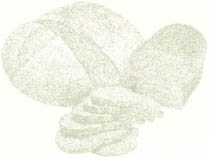
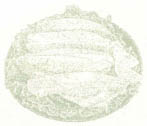
 SALMON WITH SESAME CRUST AND HONEY MUSTARD VIN BLANC SAUCE
SALMON WITH SESAME CRUST AND HONEY MUSTARD VIN BLANC SAUCE 
2 cups water
2 cups white wine
2 cups fish stock
1 onion, peeled and cut in half
2 stalks celery
1 carrot, top removed
6 cups heavy cream
1 tablespoon Thai curry paste
10 red peppercorns
1 cup whole mustard
¼ cup honey
salt and pepper to taste
10 6-ounce salmon fillets
1 egg, beaten
½ cup sesame seeds
Put water, wine, stock, onion, celery, and carrot in a thick-bottomed stainless-steel pot. Cook until reduced to 1 cup. Strain and return to pot. Add cream, curry paste, and peppercorns and reduce by  . Add mustard, honey, and salt and pepper. Brush salmon with egg, then coat top of each fillet with sesame seeds. Bake for 10 minutes at 350 degrees. Toast seeds under broiler for color just before serving. To serve, use approximately ½ cup Honey Mustard Vin Blanc Sauce per fillet. Serves 10.
. Add mustard, honey, and salt and pepper. Brush salmon with egg, then coat top of each fillet with sesame seeds. Bake for 10 minutes at 350 degrees. Toast seeds under broiler for color just before serving. To serve, use approximately ½ cup Honey Mustard Vin Blanc Sauce per fillet. Serves 10.

US 40
SCENERY HILL, PA 15360
724-945-6600
What is now US 40 was once a Nemacolin Indian trail and later the oft-traveled National Road, which opened the West to settlers and immigrants. Stephen Hill built Century Inn atop a panoramic knoll along this road in 1794 as a respite between the Pennsylvania towns of Washington and Brownsville. In those days, a team of oxen could travel only ten to twelve miles before needing rest, so hostels of this type were necessities along the National Road. Today, Century Inn presides as the oldest inn in continuous operation along the old thoroughfare.
From stagecoach passengers to wagoners, the guest list at the inn has been long and varied. In May 1825, the Marquis de Lafayette took breakfast here. Andrew Jackson was twice a guest at Century Inn. The second time was on February 1, 1829, as he was on his way to Washington, D.C., for his inauguration as the seventh president of the United States.
It was in 1945 that Dr. Gordon Harrington and his wife, Mary, purchased the inn and began acquiring antiques suitable to its history. Their son, Gordon, and his wife, Megin, are the innkeepers today. As part of their continuing efforts to maintain a decor in keeping with the inn’s past, Mary and Megin once hand-stenciled the walls in the bar, using the patterns of Moses Eaton, a recognized stenciling artisan of the early 1800s.
Likewise, executive chef Jim Shaw has researched the foods available to and served by our Pennsylvania ancestors. The menu at Century Inn reflects, but is not limited to, those traditional American dishes. Choices such as Thomas Jefferson’s Peanut Soup and Syllabub are offered. We found the Shepherd’s Pie and the Cottage Pie deliciously traditional in flavor and plentiful in quantity as luncheon entrées. The traditional Turkey with Savory Stuffing is always on the dinner menu. Or you might try Apricot Quail, filled with chestnuts and wild rice, or Duck Brackenridge, served with Port, Cranberry, and Currant Glaze. Also appealing are the Penn Forest Fillet Medallions, grilled to your specifications and coated with Dark Cherry and Black Walnut Sauce.
Whether you dine in the elegant Music Room, the sunny Garden Room, or the cozy Keeping Room at a table near its large fireplace, the atmosphere and the food will take you back to days of yore. And should you want to extend your enjoyment beyond a delicious meal in one of the five historic dining rooms, this twenty-room stone house can accommodate up to nineteen overnight guests. Although Century Inn is closed for general dining from Christmas through late March, it does host special events such as a Valentine’s weekend, business meetings, and weddings during those months.

 WILD MUSHROOM STRUDEL
WILD MUSHROOM STRUDEL 
1 shallot, chopped fine
½ cup white wine
4 ounces shiitake mushrooms, chopped coarse
4 ounces oyster mushrooms, chopped coarse
4 ounces crimini mushrooms, chopped coarse
4 ounces button mushrooms, chopped coarse
1 cup heavy cream
1 package Pepperidge Farm puff pastry sheets, thawed according to package directions
Preheat oven to 400 degrees. Place shallots and white wine in a small skillet. Heat on medium until wine is almost completely reduced. Add mushrooms and cream to skillet. Continue heating on medium until reduced by ¾. Open pastry sheets flat. Place ½ of mushroom mixture on each pastry sheet so the sheets can be folded over the mixture lengthwise. Seal edges with a fork. Cut small slits in the top to allow steam to escape. Bake on an oiled cookie sheet for 15 minutes until dough is puffed and lightly browned. Remove from oven and cool slightly before slicing into portions. Serves 8.

 SYLLABUB
SYLLABUB 
juice of 1 lemon
½ cup white wine
zest of 1 lemon, chopped fine
2 cups heavy cream
¼ cup powdered sugar
Combine lemon juice, wine, and zest. Place cream and sugar in a chilled bowl and begin whipping. When cream starts to stiffen, very slowly add lemon juice mixture. Continue whipping until mixture is stiff. Use a pastry bag with a star tip to pipe mixture into wine glasses. Serve chilled. Serves 6 to 8.
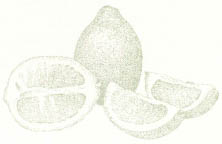
15305 KUTZTOWN ROAD
KUTZTOWN, PA 19530
610-683-7310
Whispering Springs Restaurant & Pub caught my eye as I drove along Kutztown Road while out exploring without Debbie. The imposing stone walls and colonial blue balustrades and shutters were enhanced by large carriage lamps on either side of the front door. The main dining room, known as the Kemp Room, has paneled walls, original fireplaces, and tabard draperies at each window, all of which contribute to the colonial feel. There are two other period dining rooms here as well.
Seated in the Kemp Room, I chatted with owner Greg Poletti about the restoration of this 1740 landmark. He told me that his children had refinished the beautiful poplar tabletops and that his sister-in-law was the interior decorator. It was clear that the whole family had done a terrific job of re-creating the colonial heritage in every room.
The tradition of great food and attentive service began over 250 years ago. Daniel Levan built his home in 1740. Soon afterward, it became the first tavern in the area, known as a safe haven for travelers seeking refuge from Indian raids. Levan’s Tavern was expanded in 1765 to accommodate the growing number of patrons who passed through its doors.
Many notable figures of the American Revolution, such as the Marquis de Lafayette and George Washington, passed along this road and stopped to dine or sleep as they went to and from sessions of the Continental Congress, which met in York. Records show that John Adams lodged here on September 25, 1777.
After forty-five years of keeping the inn, Daniel Levan sold the business to his son-in-law, George Kemp, who promptly renamed the inn after himself. The Kemp Hotel was kept in the family for five generations. In fact, Luther Kemp, the great-great-great-grandson of Daniel Levan, represented the proud family in 1978 when the structure was placed on the National Register of Historic Places.
After the Kemps’ tenure, the inn was renamed Whispering Springs. In 1997, the Polettis added their touch when they began to offer contemporary American cuisine in this relaxing colonial atmosphere. The varied menu offers choices such as a Lemon Pepper Chicken Sandwich, a variety of Gourmet Pizzas, and tasty entrée selections such as Shanghai Shrimp and Scallops and Grand Marnier Poached Salmon. I opted for the Maryland Crab Cakes with Garlic Parmesan Red Potatoes. The selection of warm, home-baked Bread that accompanied this dish was incredible, and the Hawaiian Pineapple Butter was as delicious as it was unusual. For dessert, I opted for the Chocolate Caramel Pecan Fudge Cake, which was everything a chocolate dessert should be.

 FISH CHOWDER
FISH CHOWDER 
3 tablespoons plus ¾ teaspoon olive oil
½ cup onion, diced coarse
½ cup red bell pepper, cut into ½-inch squares
14 ounces red potatoes, cubed
1 cup water
1 cups seafood stock
cups seafood stock
7 tablespoons dry white wine
dash of Tabasco sauce
½ teaspoon dried basil
3 tablespoons plus ¾ teaspoon tomato purée
½ teaspoon salt
½ teaspoon pepper
 cup canned tomatoes, diced
cup canned tomatoes, diced
2½ ounces clams
3 ounces shrimp, peeled and deveined
2½ ounces scallops
3 ounces catfish
1 pound mussels
2½ scallions, diced
Heat olive oil in a large soup pot and sauté onions and peppers for 10 minutes until soft and translucent. Add potatoes, water, stock, wine, Tabasco, basil, tomato purée, salt, and pepper. Cover and simmer for 15 minutes until potatoes are cooked. Add tomatoes. Cover and simmer for 15 minutes. Wash shellfish and remove muscle from scallops. Add shellfish, catfish, and mussels to other ingredients. Cover and cook for 15 minutes. To serve, pour into bowls and garnish with scallions. Serves 8.

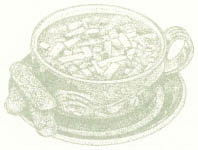
 THAI CRAB CAKES WITH CILANTRO PEANUT SAUCE
THAI CRAB CAKES WITH CILANTRO PEANUT SAUCE 
Crab cakes
1¼ pints fresh breadcrumbs
1 pint bean sprouts, chopped
½ cup green onion, chopped fine
½ cup cilantro, chopped coarse
¼ cup fresh lime juice
¼ teaspoon ground red pepper
2 large eggs
2 egg whites, beaten lightly
2 pounds lump crabmeat
cooking spray
Cilantro Peanut Sauce (see next column)
Combine first 9 ingredients in a medium bowl; cover and chill for 1 hour. Divide mixture into 8 equal portions and shape into ½-inch-thick patties. Spray a cookie sheet with cooking spray. Place crab cakes on sheet and bake at 350 degrees for 10 to 15 minutes until golden brown. Serve with Cilantro Peanut Sauce. Serves 8.
Cilantro Peanut Sauce
¼ cup red wine
 cup granulated sugar
cup granulated sugar
¼ cup soy sauce
1 teaspoon red pepper, crushed
¼ teaspoon salt
2 cloves garlic, minced
¼ cup cider vinegar
¼ cup creamy peanut butter
½ cup fresh cilantro, chopped
¼ cup fresh mint, chopped
Combine first 8 ingredients in a small saucepan and bring to a boil, stirring frequently. Remove from heat and stir with a whisk until smooth. Cool mixture, then stir in cilantro and mint. Yields 1 cup.

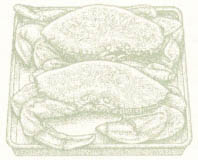
US 1 AND PA 100
CHADDS FORD, PA 19317
610-388-7361
The menu at Chadds Ford Inn is a creative combination of traditional dishes and the eclectic cuisine expected by modern diners. Shepherd’s Pie appears alongside Saffron Scampi Linguine, while Wild Mushroom Soup is served as frequently as Clam, Spinach, and Roasted Red Pepper Dip. Nibbling on Poppy Seed Rolls flavored with a hint of garlic, we had difficulty deciding from which century to dine. Ultimately, the past won out. The Shepherd’s Pie, topped with Garlic Mashed Potatoes, was delicious. Very filling, it would have sated the appetite of long-ago travelers.
It was the year 1703 when Francis Chadsey, a Quaker from Wiltshire, England, purchased five hundred acres from William Penn’s commissioner. That acreage encompassed most of what is now Chadds Ford. When Chadsey’s eldest son, who signed his name as John Chad, came of age in 1717, he took over the responsibility of operating his father’s estate. That responsibility included running the ferry that crossed Brandywine Creek.
When Chad turned the family home into a tavern in 1736, the area was known as Birmingham. However, those seeking directions were usually told to go to “the tavern at Chad’s fording place.” The name gradually caught on, and Birmingham became Chadds Ford.
Upon Chad’s death in 1760, his nephew Joseph Davis took over the tavern. During the Revolutionary War, it was Davis who entertained colonial officers in the days prior to the Battle of Brandywine, which took place near Chadds Ford on September 11, 1777. During that entanglement, colonial soldiers were forced to retreat to the Chester area. British forces swarmed the village and plundered everything in their path. The destruction to the tavern was so severe that Davis was considered to owe no property tax on it. The tavern was not issued a license to operate again until 1810. The inn has been in continuous operation since that time.
Chadds Ford Inn has seen a great deal of American history through the years. Countless Indians, settlers, and soldiers have passed these doors. Martha Washington was a guest as she made her way from Mount Vernon to spend the winter at Valley Forge. General Lafayette visited the inn on his return to the battlefield in 1825. The artists who have found comfort here include Howard Pyle, Peter Hurd, and three generations of the Wyeth family—N. C., Andrew, Henriette, and Carolyn. Their work graces the walls of Chadds Ford Inn today.
Much of the inn remains as it was when Joseph Davis rebuilt it after the Revolutionary War. Throughout most of the structure, lighting is provided by candlelight only. The fireplaces and the plank flooring are original. The draperies hanging in the deep-set windows have patterns reminiscent of crewel needlework done by ladies of a bygone era. Truly, lovers of history will not be disappointed here.

4 large onions, sliced
¼ cup garlic, chopped
1 teaspoon brown sugar
¼ cup basil, chopped
2 teaspoons thyme
1 bay leaf
¼ cup port wine
2 16-ounce cans peeled tomatoes, chopped
2 12-ounce cans chicken stock
salt and pepper to taste
garlic croutons
In a large skillet, sauté onions, garlic, sugar, basil, thyme, and bay leaf in wine until onions start to brown. Add tomatoes, stock, and salt and pepper. Bring to a boil. Continue simmering until ready to serve. Garnish with garlic croutons. Serves 6 to 8.

 POPOVERS
POPOVERS 
5 eggs
2 tablespoons butter, melted
2½ cups half-and-half
¾ teaspoon salt
2 cups flour
¾ teaspoon baking powder
Combine eggs, butter, and half-and-half in a large mixing bowl. Gradually add salt, flour, and baking powder; continue mixing for at least 10 minutes. Pour into greased muffin tins, filling them ¾ full. Bake in a preheated 375-degree oven for 12 to 15 minutes until golden brown. Yields 12 Popovers.

 BEEF AND PORTABELLO CHILI
BEEF AND PORTABELLO CHILI 
2½ pounds prime rib, cubed
2 large red peppers, diced
2 large green peppers, diced
1 bunch scallions, chopped
2 large onions, diced
2½ pounds portabello mushrooms, diced
½ bunch cilantro, chopped
1½ cups garlic, chopped
2 cups chili powder
½ cup cumin
¼ cup coriander
1 tablespoon Tabasco sauce or favorite hot sauce
1 tablespoon green Tabasco sauce
1 tablespoon cayenne pepper
28-ounce can whole peeled tomatoes
46-ounce can V-8 juice
¼ cup chocolate sauce
1 cup espresso
salt and pepper to taste
Combine first 14 ingredients in a large skillet or a Dutch oven and sauté until meat is browned. Add remaining ingredients and cook for 2 hours. Serves 12.


415 BALTIMORE STREET
GETTYSBURG, PA 17325
717-334-8838
Jennie Wade was Gettysburg’s only civilian fatality during the fierce battle fought here during the Civil War. She was shot in her home, located at the bottom of Baltimore Hill. It is believed that a Confederate sharpshooter holed up in the garret of Farnsworth House accidentally shot her. He and his comrades lay prone at a small, low window in the house, trying to shoot Union troops as they crossed Baltimore Hill. The hundred-plus bullet holes from return fire scattered across the south wall and the front of the building support the veracity of this.
The original structure dates to 1810. A brick addition constructed by John McFarland was placed at the front of the house in 1833. During the Battle of Gettysburg, the home was occupied by the Sweeney family. After the battle, the structure was renamed in honor of Elon John Farnsworth. Captain Farnsworth was promoted to brigadier general on the eve of the battle. After the failure of the Confederate army during Pickett’s Charge on July 3, 1863, Farnsworth’s regiment was sent against the right flank of Longstreet’s Confederate position. This ill-fated maneuver resulted in the death of Farnsworth and sixty-five of his men.
The house passed into the hands of the George E. Black family by the early 1900s and subsequently opened as a lodging house. From that time until the present, the home has served in that capacity. In 1972, it was purchased by the Loring H. Schultz family. Restoration to the home’s Civil War-era appearance began at that time.
Large portraits of the commanding officers at the Battle of Gettysburg, General Robert E. Lee and General George G. Meade, hang above the fireplaces in the authentically restored downstairs dining rooms. The low-ceilinged Lee Room was the original 1810 structure. We dined by candlelight in the Meade Room, crafted from the 1833 addition. Photos by famed Civil War photographer Mathew Brady were on the walls, alongside many relics from the battle. The tables were set with pewter goblets and plates engraved with a Farnsworth House likeness. Waitresses in period dress further enhanced the ambiance.
Mamie Eisenhower, the widow of President Dwight Eisenhower, was often a dinner guest at Farnsworth House when she was in the area relaxing at her nearby farm. She frequently ordered the Flounder and was very partial to Hot Fudge Sundaes for dessert.
We chose to sample food more closely tied to the home’s early years. Upon ordering, we were served Corn Relish and Pickled Watermelon Rind, along with Spoon Bread and Jenny Wade Bread. Whipped Butter and Adams County Apple Butter were brought as accompaniments. Served in its own crock, the white cornmeal Spoon Bread was tasty and different from any other we’d tried. It’s one of the many items on the menu derived from recipes left by great-great-grandmothers. Karen tried another such example of early cookery, ordering the house specialty, Game Pie. It was made from turkey, pheasant, and duck, blended with mushrooms, bacon lardoons, Red Currant Jelly, and long-grain and wild rice, all covered with a golden egg crust. Very tasty, it was served in its own oval pewter casserole. Likewise, Debbie’s Chicken Pot Pie came in an individual pewter porringer. We agreed that the Pumpkin Fritters that came with our meals were the highlight of our experience—quite a statement about a totally delicious evening.

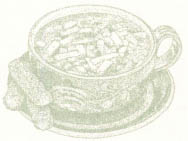
 HAM AND BEAN SOUP
HAM AND BEAN SOUP 
6 cups water
½ pound Great Northern beans, soaked overnight in cold water
2 teaspoons salt
1 small onion, chopped
pinch of white pepper
1 teaspoon parsley flakes
¼ cup ham, chopped
Place all ingredients in a large saucepan. Bring to a boil, then lower heat. Cover and simmer for 2 to 4 hours until beans are soft. Serves 8.

 RUM CREAM PIE
RUM CREAM PIE 
1¼-ounce packet unflavored gelatin
¾ cup cold tap water
4 egg yolks
½ cup sugar
3 tablespoons rum
2 cups heavy whipping cream
9-inch graham cracker piecrust
1 square unsweetened chocolate, grated or shredded
Soften gelatin in water. Heat over low heat until dissolved, then set aside to cool to lukewarm. In a mixing bowl, beat egg yolks and sugar until light and fluffy. Stir gelatin, then rum into egg mixture; mix well. Place in refrigerator. Whip cream until it stands in soft peaks. Fold cream and egg mixture together. Spoon into piecrust and refrigerate. Garnish with chocolate. Yields 1 pie.

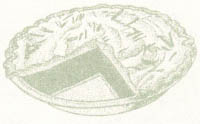
101 SKYLINE DRIVE
FARMINGTON, PA 15437
724-438-8594
It was 1806 when Secretary of the Treasury Albert Gallatin suggested a National Road, prompted by his own difficulties in traveling to Washington from his home about twenty miles from where Summit Inn is now located. The year 1813 saw construction begin on the National Road, which opened for public use in 1818 and remained the primary way west until the advent of railroads. The road was renowned for the number and excellence of its taverns. When the state of Pennsylvania began making improvements to its section of the National Road, wealthy Uniontown residents formed the Summit Hotel Company with the goal of building a mountain resort of “exceptional quality and durability.” Summit Inn, which sits atop Chestnut Ridge, is the realization of that goal.
Since 1907, guests have enjoyed the atmosphere and the quality craftsmanship of Summit Inn. Although computers have replaced the handwritten register, you can still announce your arrival to the staff at the same spot where many notable personalities signed in before you. If you consult the register page from August 19, 1918, you’ll find that Henry Ford, Thomas Edison, John Burroughs, and Harvey Firestone were at Summit Inn for a meeting of “America’s Science Wizards.” Photographs and news clippings displayed along the hallway commemorate the event.
Carefully preserved Mission-style furniture has provided generations of guests a comfortable place to sit and chat or enjoy the enormous fieldstone fireplace. Antiques abound, from a Steinway piano to an elaborately carved coatrack to Tiffany lamps, all reminders of the inn’s illustrious past. The lobby’s grand staircase, leading to the guest rooms, is a sight to behold. Just be careful. It’s said that President Warren G. Harding once took an unceremonious tumble here.
The dining room, decorated in soothing teal and peach, is just off the lobby to the left of the staircase. We had a delicious and filling breakfast of French Toast and Popeye’s Favorite, a three-egg omelet made with spinach and mushrooms.
Sated, we toured the inn. Although we were most impressed with the spacious rooms, we were continually drawn back to the wide flagstone veranda, as a warm breeze invited us to sit and enjoy the breathtaking vista across the outdoor pool and on toward the Laurel Highlands in the distance. There are many nooks and crannies from which to savor the panorama, including the popular deck area, where guests may select from a luncheon menu that includes such items as Chicken Provençal, Santa Fe Chicken, a Turkey Reuben, the Club Summit Sandwich, and Balsamic Marinated Portabello Mushroom served over Capellini. As tempting as it was to linger, other work beckoned us. We’d like to go back for lunch or dinner on a clear day to learn whether it really is possible to see all the way to Pittsburgh from atop Chestnut Ridge.

 PASTA PRIMAVERA WITH ROASTED GARLIC AIOLI
PASTA PRIMAVERA WITH ROASTED GARLIC AIOLI 
16-ounce package capellini noodles
2 cups fresh garlic, minced
½ cup vegetable oil
2 cups sherry
4 sticks butter
4 cups vegetables (carrots, zucchini, yellow squash, red or green peppers, mushrooms, or other vegetables of your choice), julienned
Cook capellini according to package directions. While pasta is cooking, sauté garlic in vegetable oil until golden. Add sherry and reduce until almost dry. Whip in butter to make the aioli. Sauté vegetables in aioli until cooked al dente. Drain pasta and toss with vegetables. Heat to desired temperature and serve. Serves 4.

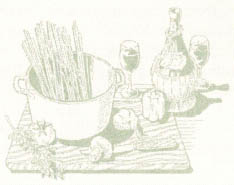

 PEANUT BUTTER CHEESECAKE WITH OREO CRUMB CRUST
PEANUT BUTTER CHEESECAKE WITH OREO CRUMB CRUST 
Oreo Crumb Crust
1¾ cups Oreo crumbs
¼ cup sugar
½ cup butter, melted
Combine Oreo crumbs and sugar. Add melted butter and mix. Press firmly into a 10-inch cake pan.
Cheesecake
7 eggs
3 egg yolks
2 cups sugar
cups sugar
5 8-ounce packages cream cheese, softened
1 cup heavy whipping cream
1½ cups creamy peanut butter
Cream eggs, additional yolks, and sugar until sugar is dissolved, adding eggs and yolks slowly 1 at a time. Cream the cream cheese in a separate bowl; add to egg mixture and combine. Add whipping cream and peanut butter and whip until blended. Pour into crust and bake at 325 degrees in a hot-water bath for about 1 hour and 20 minutes. Let cool completely before cutting. Serves 12 to 16.

505 BRIDGE ROAD (PA 113)
COLLEGEVILLE, PA 19426
610-489-1600
Valentine Hunsicker, a farmer, a weaver, and a deacon of the second Mennonite church in the United States, emigrated from Switzerland and established his homestead in Skippack and Perkioming townships in the year 1725. Many years later, after defeats at Brandywine and Germantown, Washington’s tattered troops camped near this location before retreating to their winter quarters at Valley Forge. Some accounts say that the Hunsicker farmhouse was used as a hospital for wounded soldiers.
For 170 years, this 225-acre farm nestled along Perkiomen Creek was maintained and improved by members of the Hunsicker family. At the turn of the twentieth century, the farmhouse was expanded to provide room for boarders and travelers. The year 1902 saw the addition of a kitchen, which allowed the farmhouse to begin functioning as one of the best hotels and restaurants in the area. It was known at that time as The Lily of the Valley. Through the twentieth century, the name changed several times—Millside Inn, Hill Creek Inn, and The Eagle’s Nest, in honor of Philadelphia Eagles football players who came over from their nearby training camp.
Since 1980, with the unveiling of Gypsy Rose Restaurant, Mr. Gail Mitchell has tried to recapture the eighteenth-century feeling established by Valentine Hunsicker so many years ago. Old-fashioned wainscoting shines throughout. The dining tables are each draped with a different country-print cloth. The main dining room looks out over Perkiomen Creek and the lovely grounds of the restaurant. Floral-fringed hanging lamps and floral cloth draped at the ceiling bring the greenery inside as well. The bar area, more rustic, has a large wraparound pine bar. Rough-hewn beams overhead and interesting light fixtures that appear to have been made from copper make this central area of the restaurant an appealing stop-off point.
The menu is American and includes everything from Burgers to Roast Prime Rib. Shark is a regular feature, prepared with Cajun Breadcrumbs and Lump Crab Sauce. Lump crab also appears in the Veal Ursinus, which consists of medallions of veal, crab, asparagus, and artichoke hearts in a sauce of white wine and roasted bell pepper. The plentiful Sunday brunch includes a wide range of breakfast offerings, entrée choices, and vegetable accompaniments.
We experienced Gypsy Rose for a quiet Saturday lunch. House-cured Salmon Gravlax and the Nelson New Yorker, a chicken breast served on Herbed Foccacia with fontina cheese and a roasted red pepper, were our choices. Our server was very pleasant and very interested in our research for the book, wishing us luck as we made our way to the creek-side garden area. As we followed the meandering creek, we mused about just whose footsteps we might be following.

 CHICKEN PHILADELPHIA
CHICKEN PHILADELPHIA 
2 3-ounce packages cream cheese
2 tablespoons green onion, chopped
pinch of garlic powder
salt and pepper to taste
6 6-ounce chicken breasts
6 5-by-5-inch puff pastry squares
1½ cups brown sauce
1 tablespoon freshly ground black peppercorns
1 tablespoon brandy
Preheat oven to 350 degrees. In a small mixing bowl, combine cream cheese, green onion, garlic powder, and salt and pepper. Set aside. Make a slit in each chicken breast, forming a pocket. Fill each pocket with 2 tablespoons of the cream cheese mixture, then wrap each breast in a puff pastry square. Place chicken on a greased pan and bake for about 40 minutes until golden brown. Meanwhile, combine brown sauce with ground peppercorns and brandy and heat through. Serve over chicken breasts. Serves 6.

 CRAB CAKES
CRAB CAKES 
2 cups Imperial Sauce (commercial)
6 tablespoons milk
½ cup fresh breadcrumbs
½ teaspoon baking powder
½ teaspoon Old Bay seasoning
16 ounces lump crabmeat
3 tablespoons clarified butter
Mix all ingredients except butter gently in a bowl. Form into 12 equal cakes. Melt butter in a large sauté pan. Sauté crab cakes until brown on both sides. Serve on a bed of lettuce with cocktail or tartar sauce. Serves 6.

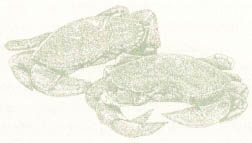
135 EAST MAHONING STREET
PUNXSUTAWNEY, PA 15767
814-938-6600
Punxsutawney Phil, the weather-predicting groundhog, has been going about his business on February 2 since 1887. Just one year younger, The Pantall Hotel is equally enjoyable—and it’s accessible year-round! Built by Theo Pantall in 1888, at the height of the logging industry, this Victorian structure was one of thirteen hotels in Punxsutawney at the turn of the century. After many years of neglect, restoration began in 1970 under the ownership of the Barletta family. On board for much of that time was Pantall’s manager, Jane Cunningham. Her love of history in general and this place in particular is evident as she recounts the many changes over the years. Today, Pantall has seventy-five rooms available for overnight guests. Notably, it hosted Bill Murray and Harold Ramis during filming of the popular movie Groundhog Day.
The Pantall Hotel’s Victorian heritage is readily apparent in the Coach Light Bar. Bartenders serve potables from behind the curly maple, cherry-stained bar, complete with ornate columns, arches, and dental molding. In its earlier years, this part of the hotel was a pretty rough place. Originally, there was a trough around the bar, complete with running water, for expectorating. That is long gone, but the original tile floor remains, along with some of the stories. Tales about Hans Olson, a partner in the Olson & Fisher Drilling Company during the early 1900s, abound. According to legend, his practice was to meet diamond merchants here, roll their diamonds dice-style onto the bar, then choose the ones he wished to purchase.
The Coach Room is open for breakfast, lunch, and dinner. Antique hutches, collectors’ plates, and framed prints line the walls. The lengthy menu includes favorites such as Swiss Steak and Chicken and Biscuits. The cost is modest. Diners can order an entrée such as Chicken and Gravy—served with Mashed Potatoes, a choice of Coleslaw or Applesauce, and a Roll—for less than you’d believe.
After lunch, we wandered through the hotel. The original marble baseboards are evident throughout the main floor. The old carved staircase sits just behind the lobby. Many of the windows throughout the lobby and the dining area still have their original glass. Partially boarded up for many years, they have recently been restored to their original condition. This allows diners to look out over the park next door, where a community bandstand is frequently in use during the warm months. The park is lined with northern maple trees; due to their age, they are frequently damaged during storms. But standing front and center in the park is a groundhog carved from a stump, salvaging what was left of one such tree in celebration of Punxsutawney’s claim to fame.

 SPINACH BALLS
SPINACH BALLS 
2 10-ounce packages frozen, chopped spinach
½ cup butter, melted
1 cup Parmesan cheese
2 cups Pepperidge Farm herb stuffing
1 onion, grated
2 large eggs
¼ teaspoon thyme
dash of pepper
Cook spinach and drain well. Place all ingredients in a large mixing bowl; mix with hands until well combined. Roll into 1-inch balls and place on an ungreased cookie sheet. Bake at 350 degrees for 15 to 20 minutes until firm but not dry. Yields 2 dozen appetizers.

 GLAZED LEMON NUT BREAD
GLAZED LEMON NUT BREAD 
4 tablespoons butter or margarine, softened
¾ cup sugar
2 eggs
2 teaspoons lemon peel, grated
2 cups all-purpose flour, sifted
2½ teaspoons baking powder
1 teaspoon salt
¾ cup milk
½ cup walnuts, chopped
2 teaspoons lemon juice
2 tablespoons sugar
Cream together butter and ¾ cup sugar until light and fluffy. Add eggs and lemon peel; beat well. Sift together flour, baking powder, and salt; add to butter mixture alternately with milk, beating until smooth after each addition. Stir in walnuts. Pour into a greased 8½-by-4½-by-2½-inch loaf pan. Bake at 350 degrees for 50 to 55 minutes until firm. Let cool in pan for 10 minutes. Combine lemon juice and 2 tablespoons sugar; spoon over top of loaf. Remove from pan and let cool. Wrap and store overnight. Slice to serve. Yields 1 loaf.
Note: Orange peel and orange juice may be substituted for the lemon peel and lemon juice.

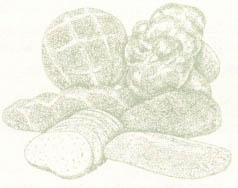
OLD US 22
LENHARTSVILLE, PA 19534
610-562-8520
For those of you who enjoy diner-type fare, Deitsch Eck is the place for you. The menu, which includes items such as a Grilled Ham Sandwich and a Patty Melt, has something for everyone among its thirty-four sandwiches and thirty platters. The platters are served with two vegetables, homemade Bread, and butter. Vegetables and side dishes such as Pepper Cabbage and Cottage Cheese with Apple Butter show the Amish influence on the area. Shoo-Fly Pie tops the list of desserts, which are predominantly homemade. We each had a mug of Apple Cider and a serving of Apple Blueberry Crumb Pie as we sampled the Pennsylvania Dutch tradition.
The Deitsch Eck Restaurant is located on the site of the Washington Hotel, which served travelers during the late 1800s and early 1900s. Soon after the turn of the twentieth century, a fire destroyed the hotel, which was replaced by the present brick building in 1914. It became known as the Lenhartsville Hotel, where rooms went for as little as a dollar per night. According to the hotel’s old menus, Iced Shrimp were priced at thirty-five cents, Clam Chowder at twenty cents, and Snapper Soup at twenty-five cents. Coffee, Tea, and Milk were offered at the unbelievable price of a nickel! Although the prices have certainly changed, one thing about the restaurant has not. The business philosophy that appeared on the hotel’s original menu is printed on today’s menu as well. “But, as we are subject to human imperfections, we stand ready to listen to any reasonable complaint and to rectify any shortcoming brought to our attention,” it reads.
Johnnie Ott, a well-known Pennsylvania Dutch artist, was one of the owners and the chef of the Lenhartsville Hotel. During his tenure in the kitchen, the restaurant was listed in a Duncan Hines publication entitled Adventures in Good Eating. Later, in 1985, the restaurant was featured in On the Road with Charles Kurault.
One of the biggest drawing cards here is the artwork of Johnnie Ott. His paintings, including those of Pennsylvania Dutch hex signs, line the walls of the restaurant. One signifies “Willkommen” or welcome. Another says, “What’s wrong?” challenging guests to figure out what is incorrect about the two pictures located in the front corner of the dining room. We got all but one of the tricky pictures, though we won’t reveal what we discovered, so as not to spoil the surprise if you stop by for a bite someday. Across the hall in a second dining room are more of Ott’s paintings, along with photographs of him at work. This room houses the building’s mahogany backbar, around which is an old tile trough. An intricate tin-tile ceiling and red-and-white picnic-style tablecloths round out the room’s decor.
In 1971, the Pennsylvania Dutch Folk Culture Society changed the name from the Lenhartsville Hotel to the Deitsch Eck Hotel. Deitsch Eck translates as “Dutch Corner,” which is apropos, since the building stands just off Interstate 78 at the corner of Old US 22 and PA 143.
Owner Steven Stetzler began working at Deitsch Eck in 1988, at the age of sixteen. At that time, he was a cook’s assistant and a dishwasher. Before graduating from high school in 1991, Steve dabbled in most of the jobs involved in the restaurant business, including managing the facility. Steve then left for college, where he pursued an associate’s degree in hotel, restaurant, and institutional management. In January 1993, the society approached Steve about returning to Lenhartsville to manage the property, since he was familiar with it. Four years later, it offered him the opportunity to buy Deitsch Eck, which he did, thus completing the journey from cook’s assistant to owner of this restaurant he knows so well.

 BUTTERMILK CUSTARD PIE
BUTTERMILK CUSTARD PIE 
2 cups sugar
4 tablespoons flour
4 eggs
4 tablespoons margarine, melted
2 teaspoons vanilla extract
1 cup buttermilk
9-inch deep-dish piecrust, unbaked
Preheat oven to 350 degrees. Combine first 6 ingredients in a bowl and mix with a wire whisk. Pour into pie shell and bake for about 45 minutes until middle doesn’t jiggle. When middle seems firm, remove pie from oven and cool. Serves 6 to 8.

 CANDIED SWEET POTATOES
CANDIED SWEET POTATOES 
½ cup plus 2 tablespoons light brown sugar
¼ cup dark brown sugar
 cup hot water
cup hot water
5 tablespoons pancake syrup
¼ cup flour
3 tablespoons margarine, melted
4 to 6 sweet potatoes
Preheat oven to 300 degrees. In a double boiler, combine light brown sugar, dark brown sugar, water, syrup, flour, and margarine. Stir occasionally. Remove from heat when mixture starts to thicken. While mixture is thickening, peel sweet potatoes and place them in cold water. Remove from water and cut into 1-inch pieces, then place pieces back in water. (Keeping peeled sweet potatoes in cold water keeps them from becoming wrinkled.) Drain sweet potatoes, place them in a large roasting pan, and pour thickened mixture over top. Place in oven and turn heat to 375 degrees. After 45 minutes, stir sweet potatoes carefully and check for softness by poking with a sharp object. Continue baking until a knife goes into and out of sweet potatoes smoothly. Sweet potatoes will be very hot when taken out of oven and will continue to cook slightly after being removed. Serves 6.

THE SUN INN RESTAURANT
564 MAIN STREET
BETHLEHEM, PA 18018
610-974-9451
The Sun Inn’s guest list over the years reads like a veritable who’s who. It’s not surprising, considering that the inn dates back to 1758. The attractive stone building, constructed by the Moravians in their traditional style, originally marked the northern edge of town. Its red-tile mansard roof was a beacon that told weary travelers miles away that food and shelter were finally within reach.
Many Revolutionary War-era statesmen were guests at the inn, including John Hancock, the Marquis de Lafayette, Ethan Allen, and John Adams. In 1787, The Sun Inn provided a respite for the Marquis de Chastellux and forty other French Academy members. The marquis exuded praise for the “venison, moor-game, the most delicious red and yellow bellied trout, the highest flavored wild strawberries, the most luxuriant vegetables.” Jimmy Carter reestablished the tradition of presidential visitors, which started with George Washington and continued with every president through James Buchanan.
The Sun Inn was so popular that it grew from its original two-story facade to a full four stories. Balconies and shops were added during the late 1800s to create an attractive Victorian hotel. However, when The Sun Inn Preservation Society was formed in 1971 to save the building from demolition, its members were not interested in the Victorian phase of the inn’s existence. Instead, they focused on returning the inn to its original appearance. Additions were removed, and the first floor was furnished as it looked when John Adams, in a letter to his wife, Abigail, described the place as “the best Inn I ever saw.” Costumed guides are available to lead entering guests on a living-history tour of these rooms.
The second floor houses the restaurant. Wide-plank floors and hooked rugs contribute to an appealing setting. A bill of fare from long ago hangs in the restaurant’s receiving area. The menu is inspired by dishes from that time, updated slightly to appeal to the modern palate. The soup choices include Governor Morris Crab Soup and Sausage, Potato, and Leek Soup, which Karen selected. Debbie sampled Benjamin Franklin’s Almond Trout, which was served with Wild Rice and Sautéed Squash of various types.
Lunch was a serene experience. We ate in a dining room with plaster walls of the very faintest sage green. Pewter candlesticks with large hurricanes were part of the table decor. Windsor chairs provided the seating, and tin lanterns alight in the deep-set windows added to the ambiance of this historic inn, which is now situated right in the middle of town.

 GOVERNOR MORRIS CRAB SOUP
GOVERNOR MORRIS CRAB SOUP 
12 cups water
½ cup crab base
½ red pepper, diced
½ green pepper, diced
½ yellow pepper, diced
16-ounce can jumbo lump crabmeat
2 tablespoons butter
4 tablespoons flour
2 cups heavy cream
Bring water to a boil. Add crab base and peppers and bring back to the boil. Cook until peppers are tender, then add crabmeat. Melt butter in a small saucepan and add flour to make a roux. Stir roux into soup to thicken. Add heavy cream, heat briefly, and serve. Serves 10.
 BENJAMIN FRANKLIN’S ALMOND TROUT
BENJAMIN FRANKLIN’S ALMOND TROUT 
2 tablespoons butter, divided
2 tablespoons almonds, sliced
2 8-ounce rainbow trout fillets, deboned
3 tablespoons almond de menthe
1 cup heavy cream
Heat 1 tablespoon of the butter in a skillet. Add almonds and trout and cook for 2 minutes. Place ½ tablespoon butter on top of each fillet. Put trout on a small broiler pan and broil for 7 to 10 minutes. To make sauce, light almond de menthe in a medium saucepan. After flame goes out, add cream. Reduce until thickened, stirring constantly. To serve, place a fillet on each of 2 plates and top with sauce. Serves 2.

